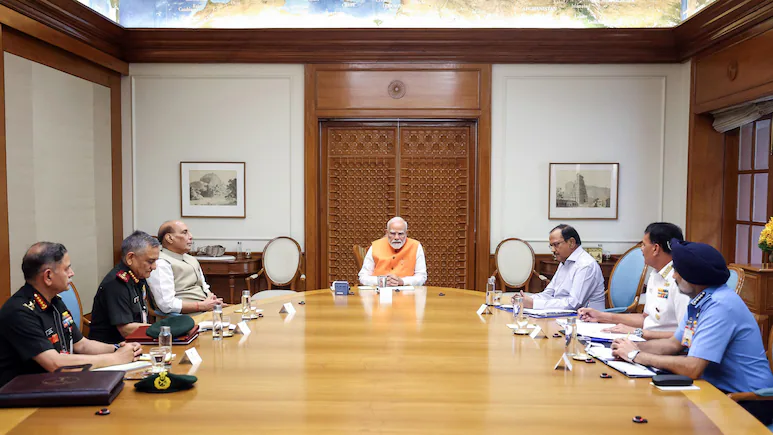How India Orchestrated Operation Sindoor
In just 15 days, India went from shock and mourning to delivering a punishing counterstrike that has left the terror ecosystem in Pakistan shaken. Operation Sindoor, a meticulously planned military response, unfolded in the early hours of May 7 with surgical precision, swift, silent, and deadly. Behind the scenes was a determined political and military leadership working in lockstep, fuelled by the grief of a nation and the resolve to hit back hard.
How India Orchestrated Operation Sindoor
The Spark: Pahalgam Massacre Shocks the Nation
April 22: A day of horror in Kashmir’s Baisaran Valley. Twenty-five tourists and a local pony ride operator were brutally gunned down in Pahalgam. Eyewitnesses say the attackers separated the victims based on religion before executing them in cold blood. The tragedy shook India to its core. Prime Minister Narendra Modi, then in Saudi Arabia, cut short his diplomatic visit and returned immediately. Home Minister Amit Shah flew to Kashmir, convening a high-level security meeting with J&K Lieutenant Governor Manoj Sinha and CM Omar Abdullah.
How India Orchestrated Operation Sindoor
The Diplomatic Blitz Begins

April 23: India launched its first salvo not with missiles, but with diplomatic firepower. The Indus Waters Treaty was suspended, the Attari check post sealed, and visa services to Pakistani nationals halted. Pakistan’s diplomatic presence in India was slashed, and defence advisors were ordered out within a week.
How India Orchestrated Operation Sindoor
A Nation United in Grief and Fury
April 24: In a rally in Bihar, PM Modi declared war not just on terrorists, but on those who shield and fund them. “This is not just an attack on tourists. It is an attack on India’s soul,” he said, promising an unimaginable punishment for the perpetrators.
April 25: Political lines blurred as 15 parties attended an all-party meeting. From Congress’s Rahul Gandhi to other opposition stalwarts, the message was clear: India stands united. Whatever steps the government takes, the country is behind it.
How India Orchestrated Operation Sindoor
Green Light for Action
April 29: In a top-secret meeting, PM Modi gave military chiefs full operational freedom, no targets were off-limits, and the timing was theirs to decide. Defence Minister Rajnath Singh, CDS Gen Anil Chauhan, and the chiefs of Army, Navy, and Air Force were present. What followed was intense behind-the-scenes coordination and surveillance.
How India Orchestrated Operation Sindoor
Preparing the Home Front
May 5: Civil defence drills were ordered across India. From blackout protocols to air raid sirens, cities ran mock preparedness exercises. Though not publicly linked to Pahalgam, the implication was clear: something big was coming.
Pressure Builds on Pakistan
May 6: A closed-door UN Security Council meeting saw global voices demanding de-escalation but not before condemning the Pahalgam massacre. Pakistan’s “false flag” narrative found no takers.
Operation Sindoor Unleashed
May 7, 1:05 am to 1:30 am- The calm of the night shattered as India launched 24 pinpoint missile strikes at nine targets in Pakistan and Pakistan-Occupied Kashmir. The mission’s objective: cripple Lashkar-e-Taiba and Jaish-e-Mohammed safe havens. Seventy terrorists were confirmed killed, and over 60 others wounded. Not a single military installation was touched. Civilian casualties were minimal, Indian sources confirmed, refuting Pakistani claims of nine deaths.
How India Orchestrated Operation Sindoor
Operation Sindoor wasn’t just a military retaliation it was a message. A message that attacks on innocent lives won’t go unanswered. That India is ready, willing, and capable of striking with speed and precision. And that in times of grief, the nation will rise not just to mourn, but to act.